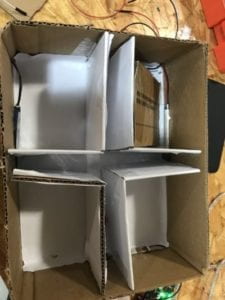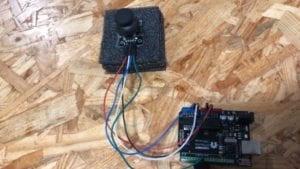U-MAZE, at first named E-MAZE, is basically a game where the player controls a ball to roll around in the maze and color the floor it passes. The original design was just like a game app on the phone where the ball colors the floor and when all of the floors are colored, you win. During the first discussion session, we were inspired to make the background floor into the image of the player. Hence the new name, U-MAZE. This may increase the interactivity of the game and make solving the maze into a process of self-recognition.
Nathan and I couldn’t decide at first what to use as the input (the Arduino part). So we did the user test session entirely on the computer, testing the Processing part. We got two repetitive valid suggestions. First of all, the color of the ball should stand out from the background image so that the player wouldn’t lose track of the ball. Secondly, instruction should be provided to tell the player that they are expected to click the mouse to take a selfie at the beginning of the game.
After the user test session, we made changes accordingly. For the first one, we decided to make the ball change its color smoothly like one of the recitation homework asked us to do with a bubble. The second one was trickier. Our game takes a selfie of the player at the beginning of the game and makes it the background of our game. If we add instruction in the Processing window, the instruction will be screenshot as well, making the background “ugly”. Finally, we came up with the idea of adding a sound instruction, literally telling the player when to do what. This plan actually proved to be popular in the final presentation.
When deciding what to use as the input, Nathan and I took three valid attempts. The first one was the six-axis accelerometer and compass, which turned out to be too tricky to serve as a simple UP-DOWN-LEFT-RIGHT input. The second one was the joystick. It kinda explains itself so I won’t introduce it here. The third one was this:

the box with a cross-road that each end has a pressure sensor detecting the movement of the dice rolling in it. We designed it in that it resembled the idea of a ball rolling in a maze. But the pressure sensors were not sensitive enough to detect a slight hit by the rolling dice. We had to give it up and went with the obvious choice – the joystick. We thought it might be too easy and therefore not fun to play with, but the result turned out to be good. Players said that the joystick was a self-explanatory input and not confusing, which is key to interactive projects.

We did make some modification to the joystick though. We made a “handle” or a “station” for the player to better get a hold on the joystick.
We added more maps of mazes to the game before the final presentation so that each time the game restarts, the maze will not be the same as the one before.
Here is a video of me playing the game.
This is my last semester at NYU Shanghai. I don’t regret taking this course, even though the workload was kinda big. I love coding and programming and writing games. It is such a proud moment when someone plays my game and “wow”s. I do hope that I can continue programming. It perfects my mind as well as makes it relax. Many thanks to my partner Nathan, who listened to my nonsense rambling when coding. Many thanks to my Professor Young and Eric and Christian who helped us in the process of our project. We couldn’t do it without your help.